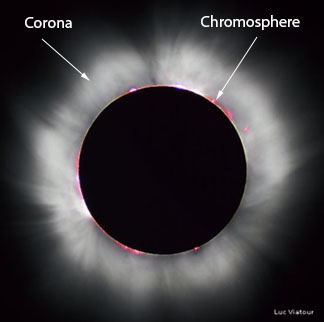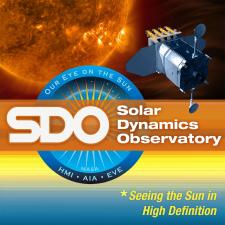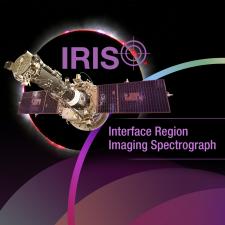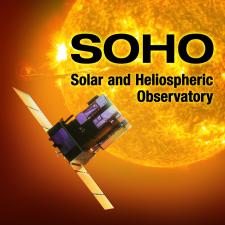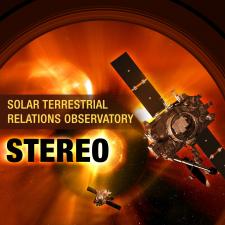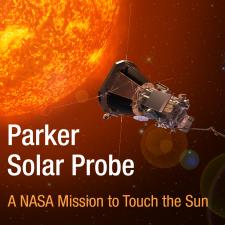The Sun
A total solar eclipse presents a rare opportunity to observe the corona and chromosphere, the two outer most layers of the sun’s atmosphere. Under normal circumstances, the bright yellow surface of the sun, called the photosphere, is the only feature we can observe. But during an eclipse, the moon blocks out that intense light, allowing scientists to observe the much dimmer solar atmosphere.
Our 2017 eclipse brochure has a composite image of the sun on the back. The brochure identifies key features in the sun’s atmosphere that you may observe during totality.
What is the Corona?
The corona is the outer atmosphere of the sun. It is made of tenuous gases and is normally hiding in plain sight, overwhelmed by the bright light of the sun’s photosphere. When the moon blocks the sun’s face during a total solar eclipse, the corona is revealed as a pearly-white halo around the sun. To study the corona, scientists use special instruments called coronagraphs, which mimic eclipses by using solid disks to block the sun's face. During a natural total eclipse, however, lower parts of the corona can be seen in a way that still cannot be completely replicated by current technology.
Eclipse observations are important for understanding why the sun’s atmosphere is 1 million degrees hotter than its surface, as well as the process by which the sun sends out a constant stream of solar material and radiation, which cause changes in the nature of space and may impact spacecraft, communications systems, and orbiting astronauts.
What Is the Chromosphere?
The chromosphere is a thin layer of the sun’s atmosphere that lies just below the corona, and about 3,100 miles (5,000 km) above the photosphere. It is only visible during total solar eclipses or with sophisticated telescopes. The word comes from chromo—or “color”—for the way this layer appears during eclipses: a thin, crimson ring around the edge of the sun, in contrast with the darkened moon and pearly-white corona.
Observing the Eclipse from Space
Several NASA missions will capture observations of the sun from space during the 2017 eclipse. Most of the imagery, with the exception of that from the Solar Dynamics Observatory, will not be available in real time, but will be shared publicly within a few days after the eclipse.
NASA solar missions that will observe the moon as it passes in front of the sun
JAXA/NASA Hinode
Hinode’s X-ray telescope, the XRT is optimal for viewing the hot corona, and these images can provide context images for ground-based eclipse observations. Eclipse scientists correlate the two sets of observations to determine where the emissions seen from the ground originate from the sun itself. One study will look at X-ray jets -- explosions that erupt from the sun's surface, expelling hot gas into the corona -- on the limb to determine where they occur more commonly. This research is best accomplished when we also have a view of the lower corona that can be seen only during a total solar eclipse.
DownloadSolar Dynamics Observatory, or SDO
Orbiting in space, NASA’s SDO mission will see a partial lunar transit. The moon will graze SDO’s view of the sun – obscuring just a small portion of the star – from 3:27 pm EDT and 3:55 pm EDT.
Throughout August 21, 2017, SDO will keep a constant eye on the sun – as it has done 24/7 since it launched in 2010. SDO views the sun in a handful of wavelengths that let it observe material on the sun in different temperatures. Each wavelength highlights material in different layers on the sun’s surface and in its atmosphere, the corona.
Scientists will be able to compare SDO imagery of the corona to images captured from the ground. During a total eclipse, the lower parts of the sun's atmosphere, or corona, can be seen in a way that cannot completely be replicated by current human-made instruments. The combination of space-based and ground-based observations together create a more comprehensive picture than either can do alone.
Interface Region Imaging Spectrograph, or IRIS
Due to its orbit in space, IRIS will witness the moon pass in front of the sun several times on Aug. 21, 2017 – each time for about 15 minutes. During the transits, IRIS will perform calibrations on its instruments.
During the rest of the time IRIS will focus on coordination with ground-based efforts observing the eclipse. The science obtained from the rare view from the ground can be amplified by IRIS’s space-based observations of the sun’s lower atmosphere – the chromosphere – as well as the loops of solar material, called prominences, visible over the sun’s limbs. IRIS will be sensitive to solar material at temperatures that cannot be seen from the ground, for example, the material in the lower atmosphere at the interface between the chromosphere and corona, which is around 100,000 K.
In addition, IRIS will obtain a scan of the whole limb which involves about 50 different pointings. The resulting mosaic image will provide a unique image of the sun’s horizon at very high resolution.
NASA missions that will observe the solar corona but will not see the eclipse:
ESA/NASA’s Solar and Heliospheric Observatory, or SOHO
Even though it won’t see the moon pass in front of the sun, one of SOHO’s key instrument suites, its coronagraphs, essentially create artificial eclipses. Humans first recorded observations of the highly structured solar atmosphere, the corona, are associated with eclipses: During a total eclipse, the much dimmer corona suddenly becomes visible, often showing a highly structured corona with solar material streaming away from the sun. In order to replicate that perspective, scientists built coronagraphs, which use a disk to mimic the moon and obscure the sun. SOHO’s coronograph will be capturing observations on Aug. 21, which can be used with ground-based observations to provide deeper insight into the processes driving the sun’s atmosphere.
DownloadSolar Terrestrial Relations Observatory, or STEREO
STEREO currently views the sun from the far side, so it, too, will not see a lunar transit on Aug. 21. However, it will also use a coronagraph to observe the corona. Scientists make use of these coronagraph images and other STEREO data to better understand what drives giant eruptions on the sun called coronal mass ejections. These eruptions can send solar material and energy toward Earth, which can -- when intense -- affect our satellites and interfere with radio communications. STEREO’s constant artificial eclipse helps us keep an eye on such eruptions, and provides situational awareness we need on Earth to mitigate such effects.
The observations STEREO gathers during the eclipse can also be used to round out observations of the solar atmosphere taken from the ground and thus create a robust, more three-dimensional picture of the sun’s dynamic corona.
Future NASA Missions
Parker Solar Probe
NASA's Parker Solar Probe will launch in 2018 to fly right into the sun’s atmosphere to provide our first-ever direct observations of the corona.
Observing the Eclipse from the Ground
NASA is funding eleven studies that span a range of disciplines, using the total solar eclipse to observe the sun, test new instruments, and even leverage the skills of citizen scientists to expand our understanding of the sun-Earth system. Of those eleven, six are sun-focused. Those studies are listed below, followed by the name of the principal investigator and their home institution.
- Two NASA WB-57 planes will take measurements of the solar corona in visible and infrared light in order to better understand how energy moves throughout the sun’s atmosphere. (Amir Caspi, Southwest Research Institute)
- Building on the work of Citizen CATE, in which citizen scientists can help gather imagery of the eclipse from wherever they are, scientists will gather additional imagery of the eclipse from two sites -- Tetonia, Idaho and Carbondale, Illinois. The experiment will map the two-dimensional electron distribution in the inner solar corona, providing new input for models that address the question of why the sun’s atmosphere, the corona, is so much hotter than its surface. (Padma Yanamandra-Fisher, Space Science Institute)
- Two experiments from a mountaintop near Casper, Wyoming, scientists will gather images of the eclipse in a wide range of light wavelengths to map the magnetic field in the sun’s corona, which can help improve models that show when the sun might erupt with a solar flare or coronal mass ejection. (Paul Bryans, University Corporation for Atmospheric Research) (Philip Judge, University Corporation for Atmospheric Research)
- During the total solar eclipse, NASA scientists will peer into the inner corona as they test an improved instrument that helps them measure polarized light, to study electrons in the corona. This experiment expands on their work from the 2016 total eclipse in Indonesia. (Nat Gopalswamy, NASA Goddard)
A team of scientists spread across four states during the total solar eclipse will use spectrometers, which analyze the light emitted from different ionized elements in the corona, as well as specialized filters to probe the physics of the sun’s outer atmosphere. (Shadia Habbal, University of Hawaii)
- NASA funded a team to train volunteers to collect images of the eclipse for the Citizen Continental-America Telescopic Eclipse (CATE) Experiment to study the dynamics of the inner solar corona from over 68 sites on the path of totality.
